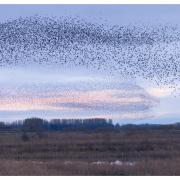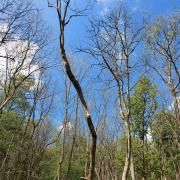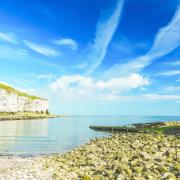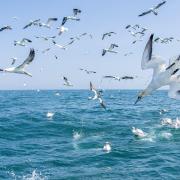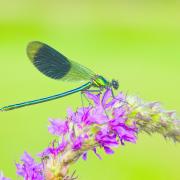They’re the largest creatures on the planet but what are your chances of seeing one here in Yorkshire? Better than you might think, as Tom Marshall from the Yorkshire Nature Triangle discovers.

It’s late summer and I’m sitting with my legs dangling over the bow of a striking sailing boat with a gently rippling royal blue sea casting countless small mirrors all around me. The afternoon sun is pleasantly warm, and with a young family just a few feet away and other shipmates relaxing around me, I try not to look like an extra from Duran Duran’s indulgent MTV video for Rio. No one quite knew where the pale-suited popstars were heading back in 1982 and our destination today remains equally mysterious, but no less exciting.
We’ve been at sea for a couple of hours now and while the company of a passing gannet or wave-surfing fulmar is welcome, minds and concentration are naturally starting to waver. Suddenly, one of the younger passengers grabs the arm of his mother and points excitedly: ‘What was that?’ With the requisite cynicism that comes with over-excitable young imaginations we slowly clamber up off the deck, but as we raise our hands to shield our eyes, the water just feet from the boat parts in an audible ‘whooosh’. In a split second, from calm ocean-going serenity the water has been parted by a huge, shiny, steely-grey back and swooping dorsal fin – we’ve been joined by a whale.
The whale in question is a minke, weighing in at around five tonnes and perhaps 30 feet in length, yet it’s moving through the water with the same effortless grace and elegance as any yacht. On board, the quiet calm has been replaced by an almost tangible rush of adrenaline, as backs are slapped in recognition and cameras hastily wrested from their tangled straps in a bid to secure the shot that shows the moment wasn’t just a tall tale (and tail) from the seas.
As another half hour ticks by, not one but four minke whales take their turn to delight the assembled mariners, initially showing themselves perhaps a hundred metres away before passing imperceptibly like a submarine beneath the waves to appear moments later in a spray of exhalation close enough to fill the camera viewfinder. In one magical moment, an adult passes silently right beside the boat, its distinctive pale pectoral fins glowing in the clear waters just below the deck. Then, as quickly as they arrived and with noticeably arched backs, the minkes dive lower in search of food, and a dozen or so spellbound whale-watchers are left comparing photographs and memories that will take top billing on the post-holiday slideshow.

The location for this memorable encounter? The sea lochs of Scotland’s west coast or the fjords of Norway, perhaps even further afield in New Zealand or Australia? No. In fact it happened within sight of the clifftops of Staithes and Whitby on the North Yorkshire coast.
Despite their huge size and status as ‘bucket list’ creatures for many, Yorkshire’s whales have only come swimming into the spotlight relatively recently, as their presence from August-October each year has become a reliable feature of autumn, passing alongside our coastline in search of herring or mackerel.
As one of the world’s smaller species – at least in the world of whales – minkes prefer shallower seas, bringing them closer to shore, and have an inquisitive nature that makes them popular with whale-watchers. Although their larger cousins are less frequent dinner guests, recent years have still witnessed appearances from the likes of humpback, sei and fin whales – the latter being second only in size to the record-breaking blue whale.
Sometimes seen as far south as the Flamborough Headland and occasionally Spurn Point, the offshore areas of Whitby, Staithes and Filey appear to be the whales’ current favourite fishing grounds. The height afforded by the cliffs in these areas also means that on calmer days those with binoculars might even be lucky enough to spot a minke from the shore, with gatherings of seabirds often a giveaway of their presence.

There is also no small irony in the fact that Whitby and its residents would once have been seen rather less favourably by these magnificent marine mammals, with its place in history as one of the north’s leading whaling towns – a chilling accolade acknowledged today by the two huge bowhead whale jaw bones overlooking the north side of the harbour entrance.
Thankfully, nowadays the boats heading out on the hunt for minkes from Staithes and Whitby will be shooting with nothing more threatening than a big lens or an iPad. Although the whaling riches of decades past brought success to these coastal towns, research today shows that alongside seabirds and other wildlife across Yorkshire, the whales have a new potential to deliver for a growing multi-million pound ‘nature tourism’ market, sparked by shows such as Springwatch and Big Blue Live.
So next time you’re looking for that once in a lifetime wildlife encounter to boast to your friends about, try a little closer to home on the Yorkshire coast (rolled up sleeves and a 1980s hairdo are optional).
A sense of porpoise
Alongside Yorkshire’s whales, keep an eye out for the diminutive harbour porpoise (Marine Drive in Scarborough is a great place to observe them) especially on calmer seas.
Although white-beaked, Risso’s and common dolphins are possible, bottlenose dolphins in particular have been recent visitors, with small pods seen last summer offshore from Flamborough and Whitby. Visit yorkshirenaturetriangle.com for more on where to go to get the latest on marine sightings.
Hop onboard
Whitby Whale Watching
Join Bryan and the team aboard the wonderful sailing boat Specksioneer (an historical reference to the chief harpoonist from days gone by) or one of their more traditional motor boats heading out from Whitby harbour. With a knowledge built up over several years developing whale watching activity in Yorkshire, the boats are often joined by researchers from Seawatch Foundation, helping to monitor minke whale movements. A useful graph on the website also shows you the best times to see whales through the year.
Real Staithes/Yorkshire Coast Nature
Sailing from the picturesque fishing village of Staithes, Sean brings aboard 30 years’ experience at sea every time he steps on to All My Sons, his own fishing vessel. After you leave the harbour, it could be as little as an hour before you’re in the heart of the action. To make the most of your trip, Sean has teamed up with Yorkshire Coast Nature – the region’s leading independent wildlife tour company, which finds Steve or Richard on hand to give you professional photographic tips and all the pointers you need for other wildlife to be spotted on the journey.












